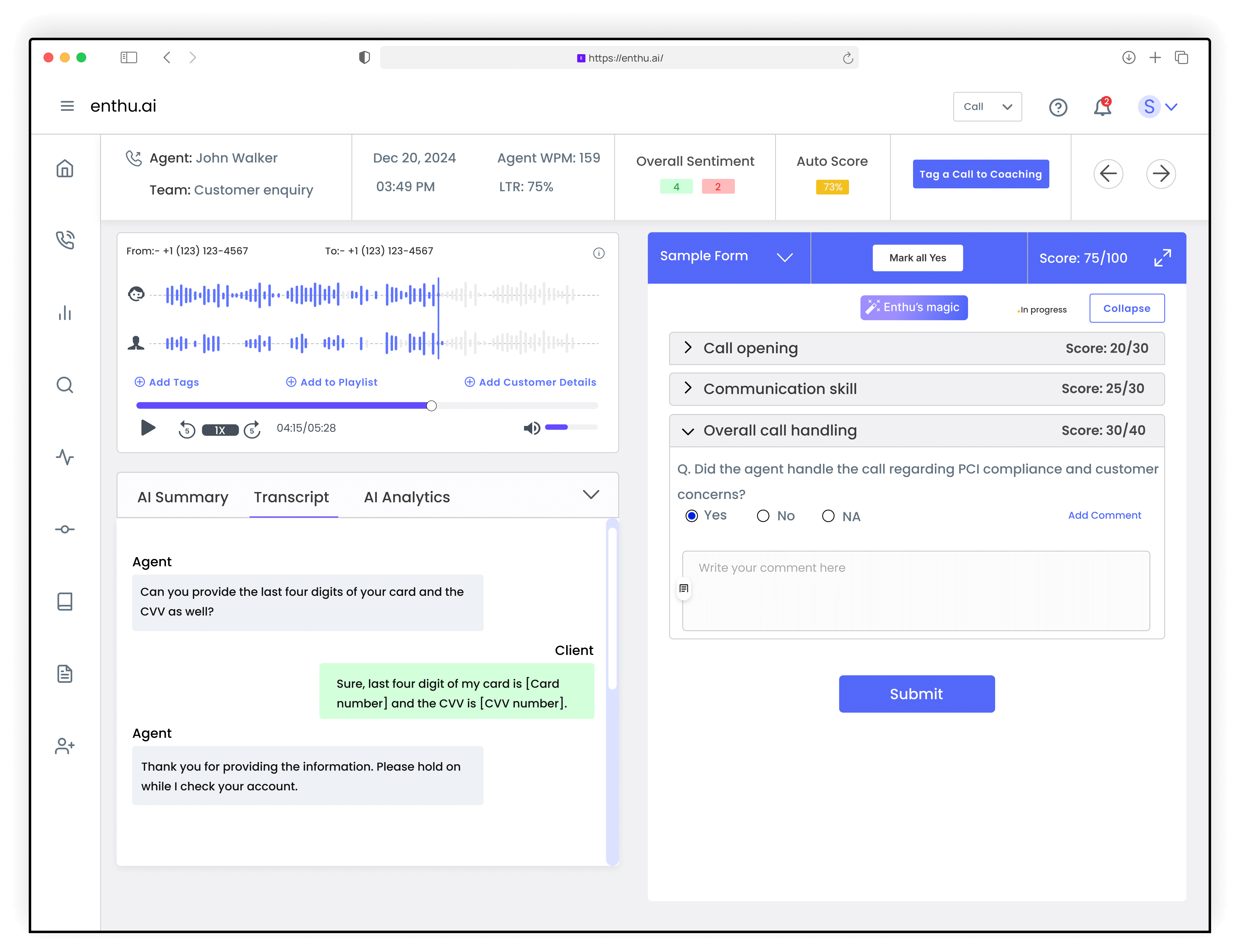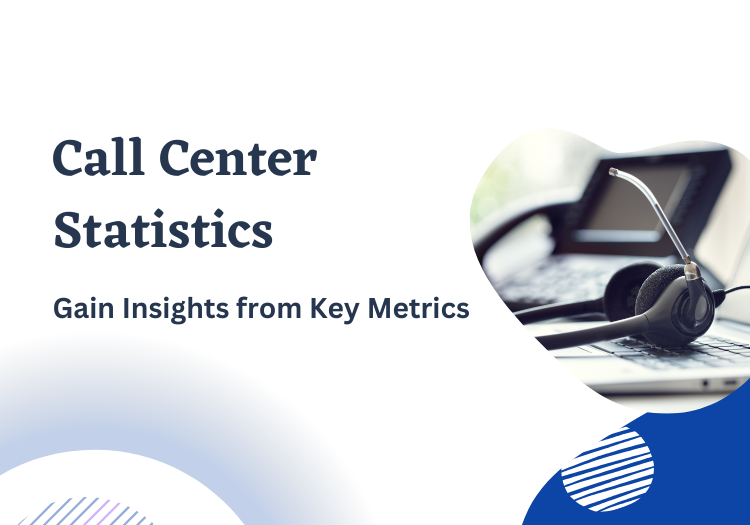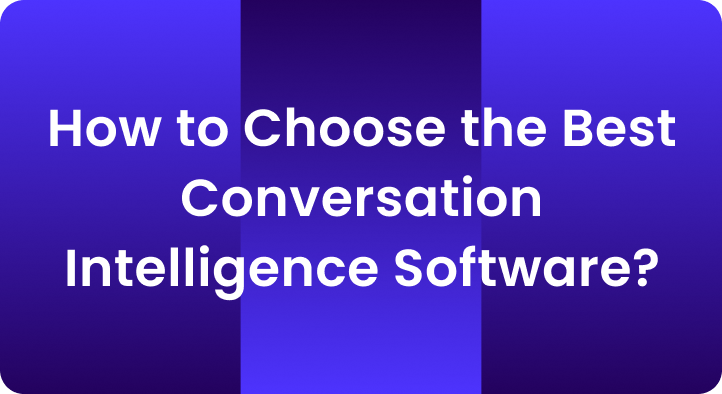Call centers have become pivotal in shaping customer perceptions and building loyalty in the modern customer-centric landscape.
Every interaction—be it a complex inquiry resolved through call monitoring, a simple FAQ addressed by a chatbot, or detailed guidance provided via live support—adds to the customer’s perception of a company.
Even one negative experience can be enough to push 80 percent of customers toward a competitor, making it vital for companies to maintain high standards of service.
For call center professionals, understanding current data, trends, and key metrics is essential for meeting and exceeding these expectations.
Call center teams can fine-tune processes and strengthen customer relationships by leveraging data on key performance indicators (KPIs) and benchmarks.
This article provides an updated list of the top 51 call center statistics, along with insights on metrics, trends, and predictions for optimizing customer support.
A. Top call center statistics according to experts
Here are 51 recent statistics on call center trends from studies around the world that will help you meet customer expectations and enhance your performance.
1. Customer experience
- 94% of American customers are likely to recommend a company that they consider to provide “very good” service. (Qualtrics XM Institute)
- 60% of customers will abandon a call if wait times exceed two minutes. (Profit.co)
- 53% of customers find it frustrating to repeat information to multiple agents. (Invoca)
- First Call Resolution rates of 70-79% indicate high satisfaction potential. (SQM Group)
- Consumers will pay a 16% price premium for a great customer experience. (Pwc)
- 1 in 3 customers will leave a brand after a bad experience. (Pwc)
- 71% of customers expect brands to deliver personalized interactions. (Mckinsey)
- Over 60% of US consumers prefer an automated self-service for simple customer service tasks (American Express)
2. Agent performance
- 87% of agents cite job stress as a significant turnover factor. (Uniphore)
- 65% of agents prefer remote work, with 96% favoring hybrid options. (Flexjobs)
- Call centers experience an average of 8.2 absentee days per year. (Bright Pattern)
- 86% of agents feel they lack the resources to resolve customer issues effectively.
- Stress-related burnout is a major cause of high turnover. (National Institute of Health)
- Predictive analytics improve efficiency and productivity by 60% (Finances Online)
- Hybrid work models increase retention and agent satisfaction. (Neuroleadership Institute)
- Outsourced call centers see higher absenteeism rates than in-house. (Avoxi)
3. Technology and automation
- 76% of centers plan to expand AI and automation in operations. (Finances Online)
- 80% of call centers use AI-based technologies to enhance customer interactions. (Gartner)
- 61% of customers try to solve their issues using self-service first. (Salesforce)
- 58% of customers use chatbots for basic queries. (Salesforce)
- 64% of consumers agree that Conversational AI are able to respond adequately to their emotions. (Zendesk)
- AI-based automation is expected to handle 10% of call interactions by 2026. (Gartner)
- 66% of call centers are looking to invest in advanced analytics to improve customer service. (knowmax)
- 64% of customer service reps who use AI say it helps them personalize their correspondences. (HubSpot, State of AI)
4. Operations and costs
- The global market value of call centers is estimated to reach $496 billion by 2027. (Smallbiz Genius)
- Between 2014 and 2023, the number of employees working in the contact center industry in the United States increased overall, despite some fluctuations. (Statista)
- The average cost-per-call for call centers ranges between $2.70 and $5.60. (F. Curtis Barry & Company)
- 80 percent of leaders plan to increase customer service budgets over the next year. (Zendesk CX Trends Report)
- Businesses lose approximately $75 billion yearly because of poor customer service. (Smallbiz Genius)
- Customers who have to wait longer than expected are 18% less satisfied with their overall experience. ( The American Customer Satisfaction Index)
- Investment in automation tools leads to significant cost savings in operations. (Openexo)
- Speech analytics can increase customer satisfaction scores up to 10% and costs down 20-30% (Mckinsey)
5. Customer Preferences
- 81.5% of customers still prefer phone or email contact for service. (Finances Online)
- Nearly 40% of internet users worldwide prefer chatbot interactions over interactions with virtual agents. (Master of Code Global)
- 60% of customers prefer human agents for banking-related queries. (The Financial Brand)
- 64% of customers would prefer that companies didn’t use ai for customer service (Gartner)
- 57% of customers from all generations prefer to engage companies through digital channels like live chat, text, social media, etc (Salesforce)
- Customers increasingly expect quick, real-time responses to their issues. (Customerzone 360)
- 63 people expect brands to use their purchase history to provide personalized experiences. (Think with Google)
- 76% of all consumers prefer the traditional medium of phone calls to reach customer support representatives. (CFI Group)
6. Industry Trends
- 59% of Millennials and 57% of Gen Z prefer to get customer support through social media channels (McKinsey).
- 66% of centers are investing in analytics to track customer satisfaction and service quality.
- 70% of customer experience leaders plan to incorporate generative AI technologies into their operations within the next two years (Zendesk).
- By 2024, over 8.4 billion voice assistant devices, like Amazon’s Alexa and Google Assistant, will be actively used worldwide. (Statista)
- Cloud-based contact center solutions are expected to grow significantly, reaching $82.43 billion by 2030. (Globe News Wire)
- The global call center industry, valued at $404.3 billion in 2020, is projected to grow to $607.6 billion by 2027. (Research and Markets)
- 91% of companies plan to increase their investments in AI and big data analytics to help improve customer care in call centers (NewVantage Partners)
- 35% of customers choose to use chatbots when available, showing their growing popularity in customer service (Time Doctor)
- The market for contact center software, valued at about $21.5 billion in 2020, is expected to nearly triple to $61.7 billion by 2026 (Expert Market Research).
- By 2025, 80% of businesses are expected to move away from native mobile apps in favor of messaging platforms like SMS or Facebook Messenger to offer better customer experiences (Gartner).
- By 2040, AI is expected to increase productivity in call and contact centers by 35% (Accenture)
B. Key efficiency metrics in call centers
To ensure a call center operates efficiently and meets customer expectations, several key metrics are essential. These metrics help track performance, identify areas for improvement, and ultimately enhance both operational efficiency and customer satisfaction.
Below, we explain each metric, its importance, and how it contributes to a call center’s overall performance.
1. Customer satisfaction (CSAT)

80% of customer service organizations use CSAT as the primary metric to measure and improve customer experience. (Harvard Business Review)
CSAT directly correlates with call center success. By tracking CSAT scores, call centers can identify areas where they need to improve. High CSAT scores indicate that customers are happy with the service they are receiving, which leads to better customer retention and positive word-of-mouth.
2. First call resolution (FCR)

Best-in-class call centers achieve an FCR rate of 74% or higher. (Nobelbiz)
FCR is a critical metric because it indicates how well agents handle customer issues without requiring follow-up. Achieving a high FCR rate improves customer satisfaction, reduces call volume, and enhances overall efficiency by eliminating the need for multiple interactions.
3. Average Handle Time (AHT)
The industry average AHT is 6 minutes and 10 seconds. (Call Centre Tools)
By monitoring and reducing AHT, call centers can handle more calls within the same timeframe, which improves productivity. However, it’s important not to lower AHT too much at the expense of quality. AHT serves as a benchmark for how efficiently agents resolve customer queries.
4. Service Level
The standard service level is often set at 80% of calls answered within 20 seconds. (Call Centre Helper)
Call centers can measure responsiveness and make staffing adjustments to meet customer expectations by tracking service levels. High service levels are indicative of efficient operations and contribute to improved customer satisfaction.
5. Call Abandonment Rate
The industry’s average call abandonment rate is around 6%, with a target of keeping it below 5%. (Fit Small Business)
Monitoring abandonment rates allows call centers to identify and address issues that may lead customers to hang up, such as long wait times or poor call routing. Reducing abandonment helps ensure customers are served promptly, improving their overall experience.
6. Employee Satisfaction

Improving agent satisfaction can boost customer satisfaction scores by 62%. (Invoca)
Call centers can reduce burnout, improve performance, and provide better customer service by fostering a positive work environment and focusing on employee satisfaction. Satisfied agents are more engaged and motivated, resulting in better customer experiences.
Explore 19 Call Center Metrics And KPIs To Watch In 2024
C. Future trends and predictions shaping call centers
The call center industry is on the verge of significant transformation, driven by technological advancements and changing customer expectations.
Here are seven key future trends and predictions shaping the future of call centers:
1. Rise of remote work and virtual contact centers
96% of employees prefer some form of remote or hybrid work post-pandemic (FlexJobs).
The shift towards remote work is expected to continue growing, with a 60% increase in remote call center agents from 2022 to 2024.
This trend is driven by the desire for flexibility and cost savings, while maintaining high-quality customer service. Cloud-based contact centers (CCaaS) are a major enabler of this transformation, projected to reach a value of $82.43 billion by 2030.
2. Adoption of conversation intelligence for enhanced customer experience

85% of call center managers are likely to implement conversation intelligence in the next year (PR Newswire).
Conversation intelligence solutions are rapidly gaining traction in call centers, helping improve agent performance and customer experience.
By processing and analyzing customer interactions in real-time, conversation intelligence enables agents to respond more effectively and efficiently. In fact, 48% of brands expect these tools to enhance customer experiences and drive increased revenue.
3. Omnichannel engagement becomes the norm
By 2030, omnichannel engagement is expected to generate $17.92 billion in revenue. (Grand View Research)
As customer expectations shift towards seamless and personalized experiences, call centers are increasingly embracing omnichannel strategies.
This approach allows customers to transition effortlessly across various communication platforms, such as voice, chat, and social media, while maintaining consistent service.
4. Increased use of sentiment analysis

Real-time sentiment analysis is set to play a crucial role in enhancing customer interactions.
By 2025, nearly 95% of customer interactions will be processed through sentiment analysis tools, enabling call center agents to tailor their responses based on customer emotions and needs, improving customer satisfaction.
5. Artificial intelligence and automation integration
The integration of artificial intelligence (AI) and automation will continue to evolve, with 76% of contact centers planning to invest in AI within the next two years. (Deloitte).
AI-powered tools, such as automated quality assurance (QA) and intelligent routing, will help increase efficiency, reduce operational costs, and provide better customer experiences at scale.
6. Voice Assistants and Self-Service Solutions
The adoption of voice assistants, driven by technologies like natural language processing (NLP) and machine learning (ML).
It is expected to skyrocket, with over 8.4 billion units in active use worldwide by 2024. (Statista)
These assistants will provide customers with efficient self-service options, reducing the demand on human agents and streamlining basic service requests.
7. Hybrid work models and manager-agent discrepancies
As hybrid work environments become more common, call centers will face challenges in balancing employee preferences with management expectations.
While 68% of agents believe hybrid work improves customer service, only 35% of managers agree. (Invoca)
This discrepancy highlights the ongoing debate around the effectiveness of hybrid versus in-person work models.
D. How can you use these statistics to improve your call center?
To maximize the impact of call center statistics and drive improvements, follow this step-by-step approach:
1. Enhance customer experience
Prioritize personalized, efficient, and seamless interactions across all customer touchpoints.
Ensuring that customers don’t have to repeat information and that their issues are resolved on the first call will help build trust and loyalty.
2. Invest in technology and automation
Implement AI and automation call center tools such as Enthu.AI to streamline operations, reduce wait times, and improve self-service options.
This will allow your agents to focus on more complex issues while handling routine queries quickly and effectively.
3. Support agent performance and retention
Provide agents with the tools, resources, and flexible work options (like hybrid or remote work) to reduce stress and increase job satisfaction.
A positive work environment will lead to better agent performance and lower turnover rates.
4. Utilize data analytics
Monitor key performance metrics such as customer satisfaction, first-call resolution, and sentiment analysis to identify areas for improvement.
Using data to drive decisions will help optimize both customer interactions and operational efficiency.
5. Adapt to changing customer preferences
Embrace an omnichannel strategy that allows customers to reach your call center through their preferred channels, whether it’s phone, email, live chat, or social media.
Ensuring that customers have a consistent experience across all platforms will meet their evolving expectations.
Conclusion
Optimizing your call center involves more than just implementing the right technology—it requires a comprehensive, customer-centric approach that integrates data-driven decision-making, agent training, and emerging solutions.
By leveraging advanced tools like Enthu.AI, you can ensure that your callers receive the best possible experience, driving customer satisfaction and long-term loyalty.
With Enthu.AI, you can ensure your agents always provide the best customer experience possible, thanks to its various AI-powered features such as call monitoring, speech analytics, call recording, agent coaching and training, quality assurance, etc.
Ultimately, continuous improvement and innovation are key to delivering exceptional customer service and staying ahead in a competitive market.
FAQs
1. What is KPI for call center?
KPI (Key Performance Indicator) for a call center is a measurable value that demonstrates how effectively the call center is achieving its key business objectives, such as customer satisfaction, efficiency, and agent performance. Common KPIs include First Call Resolution (FCR), Average Handle Time (AHT), and Customer Satisfaction (CSAT).
2. What are the top 3 call center metrics?
The top three call center metrics are:
- First Call Resolution (FCR): Measures the percentage of issues resolved on the first interaction.
- Average Handle Time (AHT): Tracks the average time an agent spends on a call.
- Customer Satisfaction (CSAT): Gauges overall customer happiness with the service received.
3. How do you measure success in a call center?
Success in a call center is typically measured by key performance indicators (KPIs) such as customer satisfaction (CSAT), first call resolution (FCR), average handle time (AHT), and service level adherence. High performance is reflected in meeting or exceeding these metrics while maintaining quality customer interactions and efficient operations.
4. What is call center statistics?
Call center statistics refer to data and metrics that track the performance of a call center, such as call volume, wait times, resolution rates, agent performance, and customer satisfaction.




 On this page
On this page


